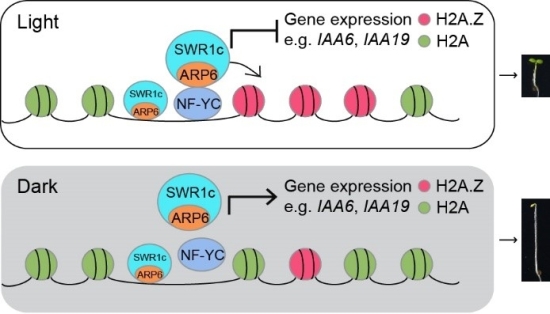

Light serves as a pivotal external signal that regulates autotrophic plant growth and development throughout the plant life cycle from germination to seed formation. After perceiving light, these photoreceptors transmit the signal through a cascade to regulate the transcriptome, ultimately triggering photomorphogenesis. During this process, the role of the histone variant H2A.Z in photomorphogenesis and its deposition mechanism remain unclear.
Dr. ZHANG Chunyu from South China Botanical Garden of Chinese Academy of Sciences have reported a mechanism of NF-YC-mediated H2A.Z deposition in photomorphogenic growth. In this study, H2A.Z deposition at its target loci is induced by light irradiation via NUCLEAR FACTOR-Y, subunit C (NF-YC) proteins, thereby inhibiting photomorphogenic growth. NF-YCs physically interact with ACTIN-RELATED PROTEIN6 (ARP6), a key component of the SWR1c that is essential for depositing H2A.Z, in a light-dependent manner. NF-YCs and ARP6 function together as negative regulators of hypocotyl growth by depositing H2A.Z at their target genes during photomorphogenesis.

Figure. A proposed model for the role of NF-YC-mediated H2A.Z deposition in photomorphogenic growth.
Upon light irradiation, NF-YCs interact with ARP6 to promote H2A.Z deposition at hypocotyl growth-related genes to repress their expression, thus inhibiting hypocotyl growth during photomorphogenesis. In the dark, NF-YCs fail to recruit ARP6 at target loci, leading to the decreased H2A.Z levels and the increased expression of hypocotyl growth-related genes, thereby promoting skotomorphogenic growth.
The study has been published in the online edition of the Journal of Integrative Plant Biology.
For further reading, please refer to: https://doi.org/10.1111/jipb.13109.

